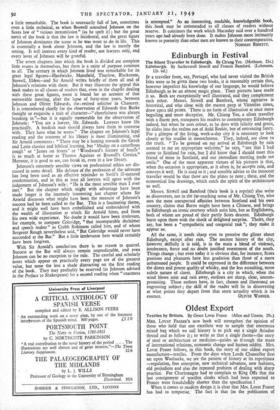Edinburgh in Festival
IF a traveller from, say, Portugal, who had never visited the British Isles were to be given these two books, it is reasonably certain that, however imperfect his knowledge of our language, he would believe Edinburgh to be an almost magic place.. Their pictures have made it so. Both are exceptionally well illustrated, and they complement each other. Messrs. Sitwell and Bamford, whose n4rrative is historical, and who close with the merest peep at Victorian times, draw upca old prints. There is no form of illustration at once more beguiling and more deceptive. Mr. Chiang Yee, a silent traveller with a fluent pen, transports his readers to contemporary Edinburgh indeed, but when he uses colour, as he does with felicity and grace, he slides into the realms not of Auld Reekie, but of entrancing fancy. For a glimpse of the living, work-a-day city it is necessary to look closely at his studies in monochrome. They, indeed, are close to the truth. " To be greeted on my arrival at Edinburgh by rain seemed to me an appropriate welcome," he says, " not that I had come to Scotland for rain,.but I did know that I should meet this friend of mine in Scotland, and our immediate meeting. made me smile." One of the most apparent virtues of his pictures is that, when the occasion is appropriate, as it often is, he accepts rain, and conveys it well. He is used to it ; and sensible advice to the innocent traveller would be that these are the plates to note ; these, and the economical line drawings, which catch the spirit of the architecture so well.
Messrs. Sitwell and Bamford (their book is a reprint) also write as discoverers, not in the far-reaching sense of Mr. Chiang Yee, who sees the most unexpected affinities between Scotland and his own country, claims that Burns might have been a Chinese, and brings to Edinburgh an ironic courtesy which suits him, but as Englishmen, both of whom are proud of their partly Scots descent. Edinburgh burst upon them with the shock of delighted surprise. Theirs, they say, has been a "sympathetic and congenial task "; they make it appear so.
All the same, it needs sharp eyes to perceive the glitter about Edinburgh, except after rain. The ancient history of the city, .however skilfully it is told, is in the main a blend of violence, intolerance, fierce and no doubt justified resentment of the south. Things change • but even today it is obvious that, for instance, Scots passions and pleasures have less gradation than those of a more unbuttoned people. It could be expressed in the difference between the direct and potent quality of whisky, and the less assaulting, more subtle nature of claret. Edinburgh is a city in which, when the wind blows mist and rain away, outlines are sharp, clear, uncom- promising. These authors have, in fact, chosen and illustrated an engrossing subject ; the skill of the reader will lie in discovering at what points they depart from that stern actuality which is its






































 Previous page
Previous page